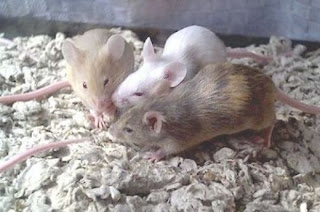Size: 4 to 6 inches
Origin: First kept as pets in China
Average Life-span: 2 to 3 years
Temperament: Active and friendly if properly socialized and interacted with
Varieties: Standard, satin, long-hair, satin long-hair, frizzie, frizzie satin and hairless; comes in many colors and patterns.
Thinking of getting a mouse? Well you're in good company! The domestic mouse, essentially the same species as the common house mouse, and has been caught and domesticated as pets for centuries. A house mouse measures about four to six inches with half that length being the tail. While white (albino) mice are the most common type found in pet stores, fancy mice can be twice the average size and come in a wide variety of coat types, colors and patterns, from curly to long and silver to cinnamon. If well cared for they can live about two to three years. Mice make curious, charming pets and will be active at various times throughout the day. However they are fragile and should be treated gently.
Mice are very social and females do especially well when kept in small groups. Males can be kept in small groups if brought up together from a young age and provided enough room, otherwise fights will break out. Do not house males and females together as they will breed rapidly and you will quickly become overrun. You can keep two to three mice together in a 10 gallon aquarium with a wire top. There should be several inches of bedding for them to burrow and nest in. You can use either aspen, hard wood shavings or reprocessed paper products. Avoid cedar and pine shavings at all costs as they can lead to health problems for your mice. Don't forget the furniture! Provide small boxes or flower pots for your mice to hide in, and cardboard tubes for them to run through and chew on. You can also add a tree branch for them to climb on. Most mice will enjoy running on an exercise wheel, so be sure to get yours one. Ladders for climbing and PVC pipes for tunneling will also be appreciated by your bright, active pets. Plastic habitats, the kind made for hamsters, will also work for mice, but keep in mind that these are harder to keep clean. I do not recommend wire cages as they are drafty and mice are very susceptible to respiratory disease, not to mention the fact that mice are escape artists and more often then not they can find their way out of wire cages.
Mice do well on a good, fortified commercial diet, either in block or pellet form. The formula you select should contain at least 16% protein, 18% fiber and no more than 4% fat. You can also offer small amounts of fruits and vegetables as treats. Peas, broccoli, carrots, apples and bananas are good foods to start with, but you may need to experiment to find which are your pet's favorites. Be careful not to overdo it though, as too many green foods can lead to loose stools. Do not give your mice cabbage, chocolate, corn, candy, junk food, uncooked beans or onions. Fresh, clean water should be available at all times, and a plastic water bottle with a drinking tube fastened to the side of the cage is the way to go.
Remove droppings, uneaten food and soiled areas of bedding from your pet's cage every day. Clean the cage completely twice a week by replacing dirty bedding and wiping down the rest of the cage. Note that male mice will produce more odor than females, so their cages may need to be cleaned more often. Like that of all rodents, a mouse's sharp incisors grow continuously throughout their lives. Provide unpainted, untreated pieces of wood, dog biscuits or safe chew toys for rodents to chew on. This is crucial for keeping their teeth in tip-top condition and prevent malocclusion and other dental problems.
Mice are very good jumpers, so you need to be careful when you take them out of their cage. You can scoop them up in your hand or in a paper cup to safely transport them. Never grab mice by the middle or end of their tails, as this can cause injuries. If you need to catch a mouse quickly you can grasp them by the base of their tail and lift them up as you cup them in your hand. Mice are smart, and can be taught tricks when well socialized, and can be let out for supervised exercise everyday.


No comments:
Post a Comment